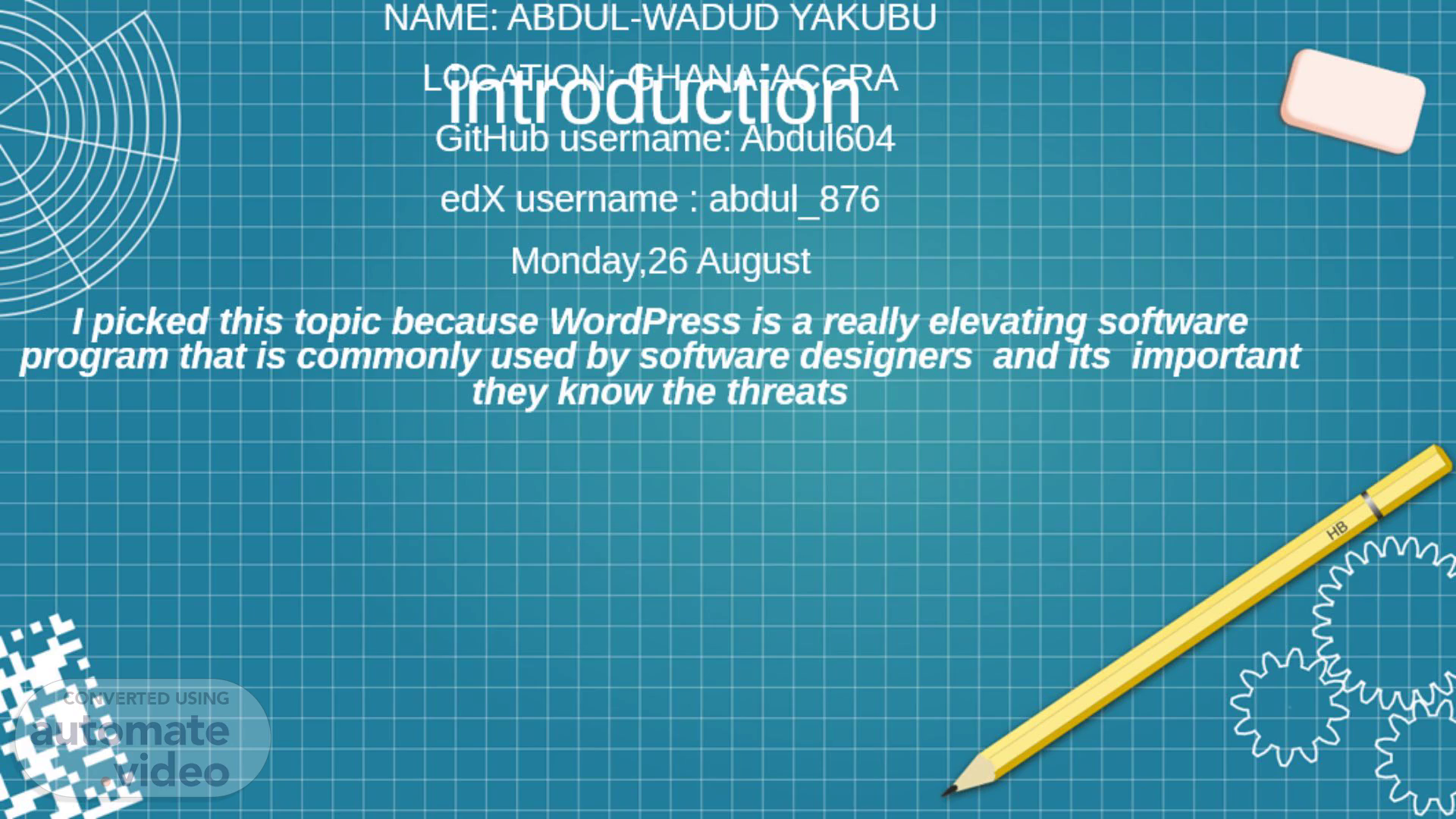Scene 1 (0s)
[Audio] We are excited to begin our presentation on WordPress security for software designers. Our presenter today is Abdul604 from Ghana, also known as abdul_876 on edX. Abdul is an expert in software design and has chosen this topic because WordPress is a very popular software program used by many software designers. However, Abdul also recognizes the importance of understanding the security risks associated with WordPress and the need for software designers to be aware of these threats..
Scene 2 (42s)
[Audio] We must ensure the security of WordPress sites. Installing security patches and keeping WordPress software up-to-date is crucial. Attackers can use plugin vulnerabilities to gain access to sensitive data, including credit card information. WordPress site designers must be aware of this risk and take preventive measures to secure their sites. The technology used in this incident was WordPress plugins, which are third-party software that can be added to a WordPress site to add functionality. In this case, the attackers exploited a vulnerability in a WordPress plugin to gain access to the site and steal credit card data. To prevent similar incidents from occurring in the future, it is essential to keep WordPress software up-to-date, use plugins from trusted sources, and regularly monitor WordPress sites for any suspicious activity and take action immediately if security issues are detected..
Scene 3 (1m 37s)
[Audio] Discuss the security risks associated with WordPress and how the Dessky Snippets plugin can be exploited to insert malicious code into the website..
Scene 4 (1m 51s)
[Audio] WordPress is a widely used content management system (C-M-S--) platform with over 60 million websites currently using it. However, just because it's widely used, it's not immune to security risks. WordPress has been a target of numerous cyber attacks in recent years, with malware attacks being the biggest security risk associated with it. Malware, short for malicious software, is a type of software designed to harm or disrupt computer systems. These attacks can range from small-scale phishing scams to large-scale data breaches. For example, attackers injected PHP-based credit card skimming malware into the checkout process of a website using the Woo Commerce plugin to steal sensitive credit card information from unsuspecting customers. Another security risk associated with WordPress is the potential for e-commerce platforms like Woo Commerce to be manipulated by attackers. To mitigate these security risks, software designers can take steps to secure their WordPress websites. This can include using strong passwords, keeping their WordPress software up to date, and using plugins like the Dessky Snippets Plugin to allow custom P-H-P code insertion. By taking these steps, software designers can help protect their WordPress websites from cyber attacks and keep their customers' sensitive information safe..
Scene 5 (3m 16s)
[Audio] We want to highlight a potentially dangerous exploitation method that can be executed by inserting malicious code into the 'wp_options' table of a WordPress site. This code can be utilized to steal credit card data during the checkout process on a WooCommerce site. The targeted data comprises of names, addresses, credit card numbers, expiry dates, and C-V-V numbers, which can be exfiltrated to a remote U-R-L--. It is crucial for software developers to recognize this risk and take measures to secure their WordPress sites against such attacks..
Scene 6 (3m 52s)
[Audio] Sensitive customer financial data is stolen, which could result in financial loss and trust erosion. This could have broader implications and similar problems could arise in other plugins leading to widespread issues. It is crucial for software designers to prioritize security when using any software to avoid any negative consequences..
Scene 7 (4m 14s)
[Audio] WordPress websites have become increasingly popular in recent years, but they are not immune to security threats. As software designers, we can take four critical steps to secure our WordPress websites. Our first step is to implement strong authentication methods, such as using strong passwords and two-factor authentication. We should also keep WordPress, plugins, and themes up-to-date to ensure that we have the latest security patches. Our third step is to limit or disable plugins that allow code insertion, as this can pose a significant security risk. Finally, we should conduct regular security audits to check for unauthorized changes and malware..
Scene 8 (4m 57s)
[Audio] Protecting WordPress sites, particularly those that handle sensitive data, is of utmost importance. Implementing the suggested preventive measures can help website owners minimize risks and safeguard their users' information. It is vital to remain vigilant and proactive in security practices to maintain a secure e-commerce environment..
